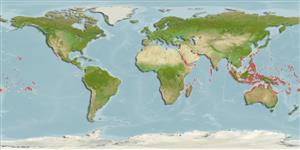Common names from other countries
Environment: milieu / climate zone / depth range / distribution range
Écologie
marin récifal; profondeur 0 - 3 m (Ref. 86942). Tropical; 32°N - 24°S
Indo-Pacific: Red Sea to the Marshall Islands, north to southern Japan, south to the southern Great Barrier Reef and New Caledonia; throughout Micronesia.
Taille / Poids / Âge
Maturity: Lm ? range ? - ? cm
Max length : 40.0 cm SL mâle / non sexé; (Ref. 1602); common length : 20.0 cm SL mâle / non sexé; (Ref. 9812)
Épines dorsales (Total) : 4; Rayons mous dorsaux (Total) : 9 - 10; Épines anales: 3; Rayons mous anaux: 9. Olive dorsally; silvery ventrally (Ref. 9812).
Occur in coastal waters, mainly in reef flats and shallow lagoon reefs; often in silty habitats Form schools at the surface (Ref. 9710, 48637). Usually swimming in surface waters near freshwater run-offs. Oviparous, eggs are pelagic and non-adhesive (Ref. 205). Used as live bait in pole-and-line tuna fishing (Ref. 9812).
Life cycle and mating behavior
Maturities | Reproduction | Spawnings | Egg(s) | Fecundities | Larves
Myers, R.F., 1991. Micronesian reef fishes. Second Ed. Coral Graphics, Barrigada, Guam. 298 p. (Ref. 1602)
Statut dans la liste rouge de l'IUCN (Ref. 130435)
CITES (Ref. 128078)
Not Evaluated
Menace pour l'homme
Harmless
Utilisations par l'homme
Pêcheries: sans intérêt; appât: usually
Outils
Articles particuliers
Télécharger en XML
Sources Internet
Estimates based on models
Preferred temperature (Ref.
115969): 25.2 - 29.3, mean 28.5 (based on 2805 cells).
Phylogenetic diversity index (Ref.
82804): PD
50 = 1.0000 [Uniqueness, from 0.5 = low to 2.0 = high].
Bayesian length-weight: a=0.00977 (0.00600 - 0.01591), b=2.89 (2.75 - 3.03), in cm Total Length, based on LWR estimates for this species & (Sub)family-body (Ref.
93245).
Niveau trophique (Ref.
69278): 2.4 ±0.2 se; based on size and trophs of closest relatives
Résilience (Ref.
120179): Milieu, temps minimum de doublement de population : 1,4 à 4,4 années (Preliminary K or Fecundity.).
Fishing Vulnerability (Ref.
59153): Moderate vulnerability (39 of 100).
